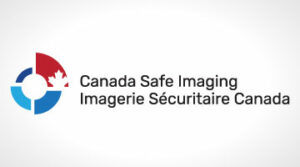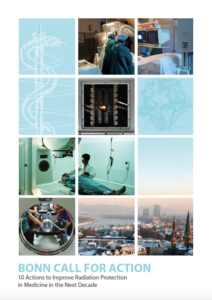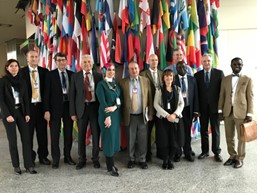
Veuillez noter que ce contenu n'est présentement disponible qu'en anglais.
À propos
Imagerie sécuritaire Canada (ISC) a été créé en 2015 pour répondre au besoin d'une stratégie nationale et d'un plan d'action au Canada, afin de renforcer la radioprotection médicale des patients et de favoriser une culture de radioprotection dans le secteur des soins de santé au Canada.
ISC est le fruit d'une collaboration entre les agences gouvernementales, les associations professionnelles, les universités, les collèges, les institutions nationales de recherche et les hôpitaux. Dans chaque secteur, une approche multidisciplinaire a également été adoptée, impliquant des partenaires, des chercheurs, des technologues, des physiciens médicaux et des physiciens de la santé, ainsi que d'autres prestataires de soins de santé utilisant ou prescrivant l'utilisation de rayonnements.
Imagerie sécuritaire Canada fait partie d'un réseau mondial de campagnes de radioprotection menées sous les auspices de la International Society of Radiology (Société internationale de radiologie).
Mission
Proposer des lignes directrices et des outils canadiens contextualisés pour la radioprotection des patients.
Responsibilités
- Promouvoir l'application des connaissances, l'adoption et le respect des bonnes pratiques et normes de radioprotection dans l'environnement médical canadien;
- Entreprendre des stratégies et des initiatives potentielles futures pour améliorer la radioprotection de l'imagerie médicale et les soins;
- Élaborer et promouvoir un programme de recherche stratégique pour la radioprotection des patients au Canada.
Contexte
Les technologies d'imagerie médicale d'aujourd'hui offrent une visibilité sans précédent sur le corps. Les technologies et les techniques d'imagerie médicale continuent d'évoluer rapidement, de même que leur utilisation et l'exposition subséquente des patients aux rayonnements ionisants.
Même si la technologie s'est considérablement améliorée et que les doses de radiation ont diminué, le risque d'exposition n'a pas disparu et doit être pris en considération lorsque des tests utilisant des radiations ionisantes sont prescrits. Comme beaucoup de choses que nous tenons pour acquises, nous ne voyons plus les risques liés à la technologie à mesure qu'elle fait partie de notre vie. Mais il est nécessaire de rester vigilant, de sensibiliser et d'éduquer les professionnels de la santé et la population dans son ensemble sur les risques et les avantages des rayonnements ionisants en médecine.
En 2012, l'Agence internationale de l'énergie atomique (AIEA) et l'Organisation mondiale de la santé (OMS) ont lancé une initiative soutenue par 77 pays et 16 organisations, intitulée, Bonn Call For Action, qui décrit dix stratégies majeures pour promouvoir la radioprotection. En réponse à cette initiative, une nouvelle campagne a été mise sur pied, qui rassemble de nombreuses parties prenantes afin de renforcer la radioprotection médicale au Canada selon une approche inclusive. La prestation des soins de santé est une responsabilité provinciale, mais une stratégie nationale ciblée et un effort unifié sont nécessaires pour assurer la radioprotection en imagerie médicale pour tous les Canadiens.
Imagerie sécuritaire Canada (ISC) a été créé pour répondre au besoin d'une stratégie nationale et d'un plan d'action en matière de radioprotection pour les soins d'imagerie médicale au Canada.



 In December 2017, the IAEA, in partnership with the WHO and the Pan-American Health Organization, hosted the International Conference on Radiation Protection in Medicine: Achieving Change in Practice in Vienna, Austria. The goal of this conference was to provide an overview of the actions and developments since the 2012 Bonn conference.
In December 2017, the IAEA, in partnership with the WHO and the Pan-American Health Organization, hosted the International Conference on Radiation Protection in Medicine: Achieving Change in Practice in Vienna, Austria. The goal of this conference was to provide an overview of the actions and developments since the 2012 Bonn conference.
